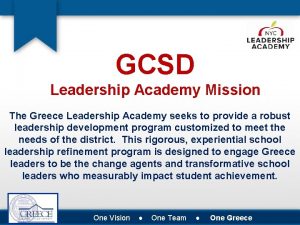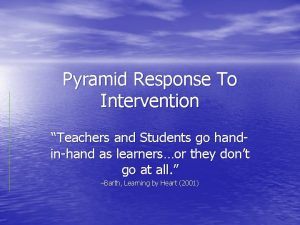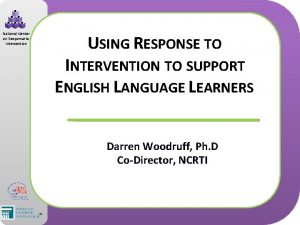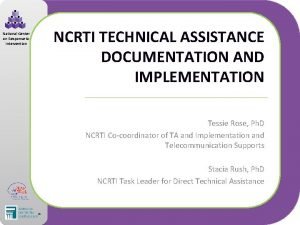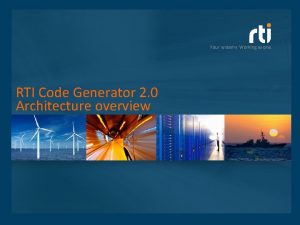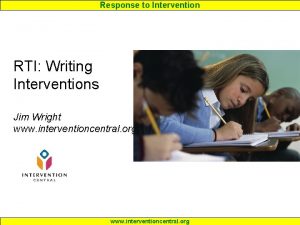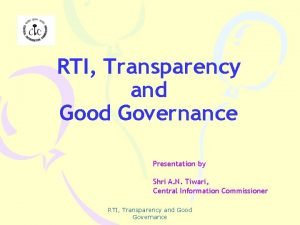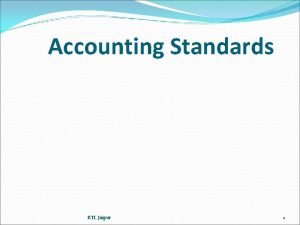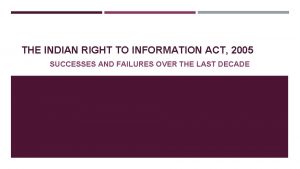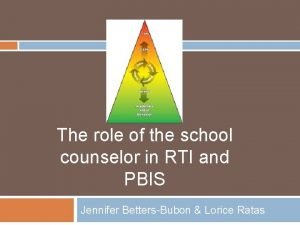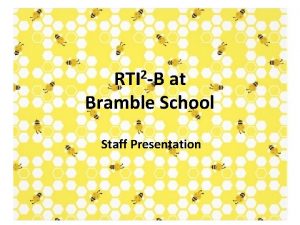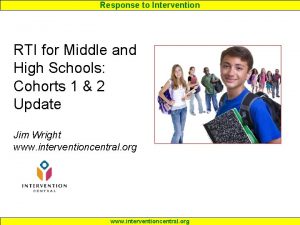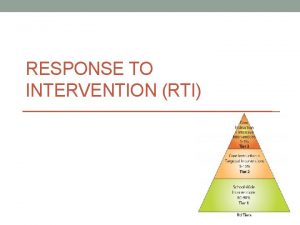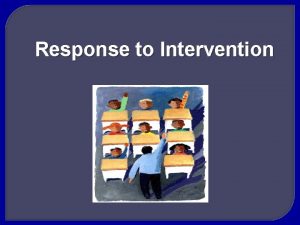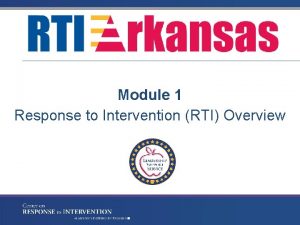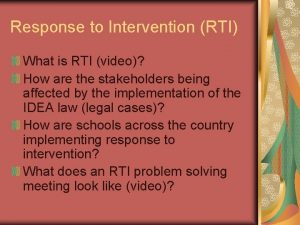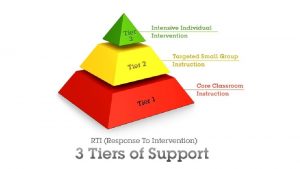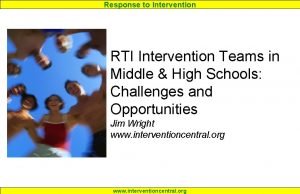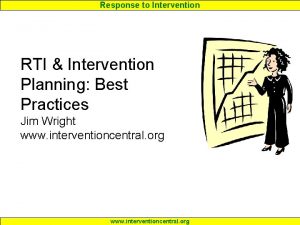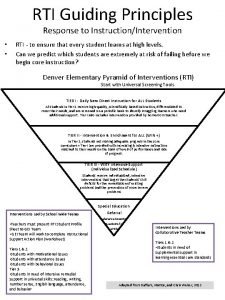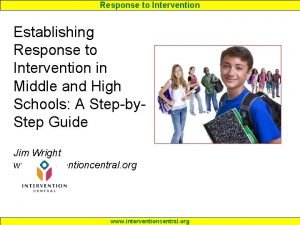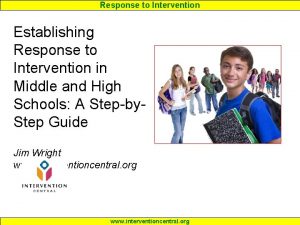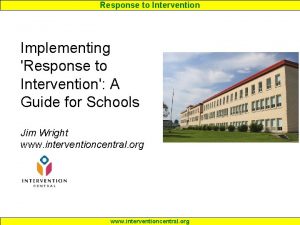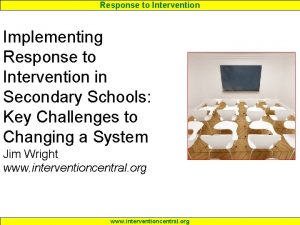Response to Intervention RTI What is Response to















- Slides: 15

Response to Intervention RTI

What is ‘Response to Intervention’ (RTI)? Response to Intervention (RTI) is a useful decision-making “tool” and process. The RTI process is a multi-step approach to providing services and interventions at increasing levels of intensity. The progress students make at each stage is closely monitored. Results of this monitoring are used to make decisions about the need for further research-based instruction and/or intervention in general education, special education, or both.

RTI – IST – PBIS n The similarities of RTI and PBIS. n n n Research-validated For academics and behavior Universal Interventions – emphasis is on prevention Phases of tiered interventions; interventions based on research Progress monitoring Using data to inform decision making

Designing School-Wide Systems for Student Success Academic Systems Behavioral Systems Intensive, Individual Interventions • Individual Students • Assessment-based • High Intensity 1 -5% Targeted Group Interventions • Some students (at-risk) • High efficiency • Rapid response Universal Interventions • All students • Preventive, proactive 5 -10% 80 -90% 1 -5% Intensive, Individual Interventions • Individual Students • Assessment-based • Intense, durable procedures Targeted Group Interventions • Some students (at-risk) • High efficiency • Rapid response 5 -10% 80 -90% Universal Interventions • All settings, all students • Preventive, proactive

Legal Background Why RTI is now being adopted by schools Congress passed the revised Individuals with Disabilities Education Improvement Act (IDEIA) in 2004 ▪ This Federal legislation provides guidelines that schools must follow when identifying children for SPED ▪ Based on the changes in IDEIA 2004, the US Department of Education updated its regulations to state education departments which include: ~ Explicitly ALLOW states to use RTI to identify LD ~ FORBID states from forcing schools to use a ‘discrepancy model’ to identify LD

IDEIA 2004 -05 Federal Regulations: What they say about LD diagnosis § 300. 307 Specific learning disabilities. (a) General. A state must adopt criteria for determining whether a child has a specific learning disability. . . the criteria adopted by the State (2) May not require the use of severe discrepancy between intellectual ability and achievement for determining whether a child has a specific learning disability as defined in § 300. 8 (Discrepancy Model) (3) Must permit the use of a process that determines if the child responds to scientific, research-based intervention (ie. RTI Model)

How does RTI relate to LD & the steps implementation of RTI and LD RTI Implementation ▪A student with academic delays is given Under RTI, if a student is found to be performing well below peers, the school will: ▪Academic progress is monitored frequently to see if interventions are sufficient to help the student catch up with peers 1. ▪If the student fails to show significantly improved academic skills despite several well-designed and implemented interventions, this failure to ‘respond to interventions’ can be viewed as evidence for an underlying LD 4. one or more research-validated interventions 2. 3. 5. Estimate academic skill gap between student and peers Determine likely causation Select scientifically-based interventions Use progress monitoring to evaluate the impact of interventions If student fails to respond to several well-implemented interventions, a possible consideration for CSE referral may take place

October 4, 2007 PART 100. 2(ii) of the NYS Commissioner of Education’s Regulations ~ amended officially & permanently ~ Section 100. 2(ii) Response to Intervention programs. (1) A school district’s process to determine if a student responds to scientific, research-based instruction shall include the following minimum requirements: (i) Appropriate instruction delivered to all students in the general education class by qualified personnel; (a) appropriate instruction in reading shall mean scientific research-based reading programs that include explicit and systematic instruction in phonemic awareness, phonics, vocabulary development, reading fluency (include oral reading skills) and reading comprehension strategies

Part 100 Continued (ii) (iv) (vi) (2) (3) screenings all students in class to identify those students who are not making academic progress at expected rates; instruction matched to student need with increasingly intensive levels of targeted intervention and instruction for students who do not make satisfactory progress in their levels of performance and/or in their rate of learning to meet age or grade level standards; repeated assessments of student achievement which should include curriculum based measures to determine if interventions are resulting in student progress toward are or grade level standards; the application of information about the students response to intervention to make educational decisions about changes in goals, instruction and/or services and decisions to make a referral for special education programs and/or services; written notification to the parents when the student requires an intervention beyond that provided to all students in the general education classroom that provides information about: (a) the amount and nature of student performance data that will be collected and general education services that will be provided pursuant to paragraph (2) of this subdivision A school district shall select and define the specific structure and components of the response to intervention program, including, but not limited to, the criteria for determining the levels of intervention to be provided to students, the types of interventions, the amount and nature of student performance data to be collected and the manner and frequency for progress monitoring A school district shall take appropriate steps to ensure that staff have the knowledge and skills necessary to implement a response to intervention program and that such program is implemented consistent with paragraph (2) of this subdivision

In Addition – Changes to PART 200. 2(b)(7) Written policy. Each Board of Education or board of trustees shall adopt written policy that establishes administrative practices and procedures; (1)-(6)… (b) (7) For implementing school wide approaches, which may include a response to intervention process pursuant to section 100. 2(ii) of this Title, and pre-referral interventions in order to remediate a student’s performance prior to referral for special education

What We Know & What Already Exists…

RTI’s Three-Tiered Intervention Model Tier 1 Interventions are universal, and available to all students. Teachers often deliver these interventions in the classroom. Key Questions: Are routine classroom instructional modifications sufficient to help the student achieve academic success? n n n Standards & scientifically based whole class instruction Available to all students High quality instructional and behavioral supports in general education School-wide screening & group intervention Differentiated instruction

RTI’s Three-Tiered Intervention Model Tier 2 n Interventions are individualized, and tailored to the unique needs of struggling learners. They are reserved for students with significant skill gaps who have failed to respond successfully to Tier 1 strategies. n Key Questions: Can an individualized intervention plan carried out in a general-education setting bring the student up to the academic level of his/her peers? n n n Additional support above & beyond that of peers Individual intervention plans Interventions are aligned with specific student needs Individualized & targeted, shortterm intensive interventions/remediation Progress monitoring & documentation of progress towards targeted goals

RTI’s Three-Tiered Intervention Model Tier 3 Interventions are the most intensive academic supports available in a school and are generally reserved for students with chronic and severe academic delays or behavioral problems n n n Key Questions: What ongoing supports does this student require and in what settings should they be provided to facilitate the greatest success possible? n Longer-term intensive instructional interventions designed to increase their rate of progress Special Education or 504 eligibility might be considered Individualized diagnostic assessments used to evaluate and distinguish deficit areas in order to design individualized instructional plan Evaluation by multi-disciplinary team if low achievement & insufficient response criteria are met

Applying the Tiers to our Middle School Expanding Tier 1 to Unite with AIS Tier 1 – Classroom-based interventions/modifications a) b) Read all directions aloud Low Intensity AIS needs (Academic Intervention Services provided by classroom teacher or possibly reading specialist – depending on level of need) Tier 2 – Individualized intervention component a) b) 1: 1 or small group targeted reading interventions High Intensity AIS needs Tier 3 – Highest level of interventions available (possible CSE or 504 classification). Tier 3 does not always mean a CSE classification or a 504 plan will follow.
 Simplifying response to intervention
Simplifying response to intervention Response to intervention pyramid
Response to intervention pyramid National center for response to intervention
National center for response to intervention National center on response to intervention
National center on response to intervention Rti code
Rti code Jim wright rti
Jim wright rti Rti and good governance
Rti and good governance Rti zeromq
Rti zeromq List of accounting standards in india
List of accounting standards in india Rti act 2005 introduction
Rti act 2005 introduction Rti school counseling
Rti school counseling Rti meaning real estate
Rti meaning real estate Rti 2
Rti 2 Upper rti
Upper rti Rti scheduler
Rti scheduler Pegasus opera 3 review
Pegasus opera 3 review
